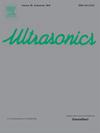Towards improving breast cancer detection through multi-modal image generation
IF 3.8
2区 物理与天体物理
Q1 ACOUSTICS
引用次数: 0
Abstract
Ultrasound (US) imaging is real-time, less expensive, and more portable, compared to mammography, which makes it better suited for screening in resource-constrained settings and intra-operative imaging. However, US has lower spatial resolution and more artifacts compared to mammograms. This research aims to address these limitations by providing surgeons with mammogram-like image quality in real-time from US images. Previous approaches to US enhancement have discarded the artifacts created by interaction pattern between ultrasound and tissue by treating them as noise. By contrast, we recognize the value of the artifacts as wave interference patterns (WIP) that capture important tissue characteristics. In particular, we utilize the Stride software to numerically solve the forward model by generating US images from mammograms by solving wave-equations and add the high-frequency components separately to produce realistic US images. This forward generation itself is of clinical value because sometimes US acts as a complementary imaging modality to disambiguate cases that are difficult to diagnose using mammograms alone. Then, we train a generative adversarial network (GAN) for the obtaining mammogram-quality images from US. The resultant images have considerably more discernible details than the original US images. With further improvements, both forward and backward image generation can help simulate complementary modality on-the-fly to aid better breast cancer diagnosis in a cost-effective and real-time manner.

通过多模态图像生成改进乳腺癌检测
与乳房x光检查相比,超声(US)成像是实时的、更便宜的、更便携的,这使得它更适合在资源有限的情况下进行筛查和术中成像。然而,与乳房x光检查相比,US的空间分辨率较低,伪影较多。本研究旨在通过为外科医生提供实时的乳房x线照片图像质量来解决这些限制。先前的超声增强方法将超声与组织之间的相互作用模式产生的伪影视为噪声而丢弃。相比之下,我们认识到作为捕获重要组织特征的波干涉图案(WIP)的人工制品的价值。特别是,我们利用Stride软件通过求解波动方程从乳房x光片生成US图像来数值求解正演模型,并单独添加高频分量以生成逼真的US图像。这种正向生成本身具有临床价值,因为有时US作为一种补充成像方式来消除仅使用乳房x光检查难以诊断的病例。然后,我们训练了一个生成对抗网络(GAN)来获取来自美国的乳房x线照片质量图像。合成的图像比原始的美国图像有更多可识别的细节。随着进一步的改进,向前和向后的图像生成都可以帮助模拟互补模式,以经济有效和实时的方式帮助更好的乳腺癌诊断。
本文章由计算机程序翻译,如有差异,请以英文原文为准。
求助全文
约1分钟内获得全文
求助全文
来源期刊

Ultrasonics
医学-核医学
CiteScore
7.60
自引率
19.00%
发文量
186
审稿时长
3.9 months
期刊介绍:
Ultrasonics is the only internationally established journal which covers the entire field of ultrasound research and technology and all its many applications. Ultrasonics contains a variety of sections to keep readers fully informed and up-to-date on the whole spectrum of research and development throughout the world. Ultrasonics publishes papers of exceptional quality and of relevance to both academia and industry. Manuscripts in which ultrasonics is a central issue and not simply an incidental tool or minor issue, are welcomed.
As well as top quality original research papers and review articles by world renowned experts, Ultrasonics also regularly features short communications, a calendar of forthcoming events and special issues dedicated to topical subjects.
 求助内容:
求助内容: 应助结果提醒方式:
应助结果提醒方式:


